Microwave ablation instrument with insertion probe
a microwave ablation and probe technology, applied in the field of microwave ablation instruments, can solve the problems of unacceptably increasing surgical risk, early postoperative intrahepatic recurrence, poor prognosis of patients with unresectable hepatocellular carcinoma (hcc) tumors,
- Summary
- Abstract
- Description
- Claims
- Application Information
AI Technical Summary
Benefits of technology
Problems solved by technology
Method used
Image
Examples
Embodiment Construction
[0032]While the present invention will be described with reference to a few specific embodiments, the description is illustrative of the invention and is not to be construed as limiting the invention. Various modifications to the present invention can be made to the preferred embodiments by those skilled in the art without departing from the true spirit and scope of the invention as defined by the appended claims. It will be noted here that for a better understanding, like components are designated by like reference numerals throughout the various FIGURES.
[0033]Turning now to FIGS. 1-3, a microwave ablation assembly, generally designated 20, is provided including a relatively thin, elongated probe 21 having a proximal access end 22 and an opposite distal penetration end 23 adapted to penetrate into bio-tissue 25. The probe 21 further defines an insert passage 26 extending therethrough from the access end 22 to the penetration end 23 thereof. The ablation assembly 20 further includes...
PUM
 Login to View More
Login to View More Abstract
Description
Claims
Application Information
 Login to View More
Login to View More - R&D
- Intellectual Property
- Life Sciences
- Materials
- Tech Scout
- Unparalleled Data Quality
- Higher Quality Content
- 60% Fewer Hallucinations
Browse by: Latest US Patents, China's latest patents, Technical Efficacy Thesaurus, Application Domain, Technology Topic, Popular Technical Reports.
© 2025 PatSnap. All rights reserved.Legal|Privacy policy|Modern Slavery Act Transparency Statement|Sitemap|About US| Contact US: help@patsnap.com



